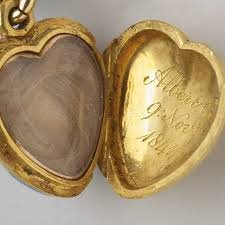History of a heart jewelry
The heart shape we know and cherish today has a fascinating history that spans nearly a millennium. While we might think of it as a simple symbol – one we've all attempted to perfect in Valentine's Day cards or childhood art projects – its evolution tells a remarkable story of love, faith, and cultural transformation.
A man offering his heart to his beloved
The heart's tale as a symbol begins in the midst of Medieval Europe, first appearing in a 13th-century manuscript showing a man offering his heart to his beloved. Interestingly, this early heart looked quite different from our modern version – it pointed upward and lacked the familiar scalloped shape we know today. It wasn't until the 14th century that the heart began to take on its more recognizable form.
In Medieval Europe, where symbols spoke louder than words to a largely illiterate population, the heart became a powerful emblem of both romantic and spiritual love. This was the era of chivalric romance, when tales of King Arthur's knights and courtly love captured imaginations. The symbol gained particular momentum after Geoffrey Chaucer's 1382 love poem "The Parliament of Fowls," which helped establish the connection between hearts, love, and Valentine's Day.
Witch’s heart
The heart's journey through jewelry history is particularly enchanting. In 17th century Scotland, the distinctive "witch's heart" design emerged – an asymmetrical heart with a twisted tail, typically pointing right. These pieces, known as "Luckenbooth" brooches after the Edinburgh shops where they were sold, began as protective talismans for loved ones and babies. By the 18th century, they transformed into romantic tokens, symbolizing being "bewitched" by love.
The Georgian era saw an explosion of heart-shaped jewelry, with crystal lockets becoming particularly fashionable. These pieces often held intimate tokens like locks of hair from loved ones, while empty crystal lockets represented truth and purity. The addition of a crown atop these pieces symbolized loyalty, creating a rich language of love through jewelry design.
A "secret picture" of Queen Victoria painted as a gift for Albert. In this picture Victoria is wearing a heart-shaped locket with Albert’s hair
Queen Victoria, the great trendsetter of the 19th century, played a crucial role in popularizing heart jewelry. Her own collection included elaborate pieces like a charm bracelet featuring enameled heart lockets containing her children's hair. She wore heart-shaped pieces during both joyous occasions and periods of mourning, cementing the symbol's versatility as an expression of all forms of love.
Interior of a heart locket with child’s hair Queen Victoria used to wear on her bracelet. In total she had 9 lockets, one for each child
Throughout history, the heart symbol has appeared in countless variations: blazing hearts, twin hearts symbolizing intertwined love, hearts pierced by arrows representing love's conquest, and hearts surrounded by pearls signifying beauty. Each design carried its own meaning, creating a rich vocabulary of romantic expression through jewelry.
Today, when we craft heart-shaped jewelry, we're not just creating beautiful accessories – we're continuing a centuries-old tradition of expressing love through precious metals and gems. Each piece carries whispers of medieval manuscripts, Scottish folklore, Georgian romance, and Victorian sentiment, making them not just symbols of love, but carriers of our shared human history.
Gold plated heart pendant with Emerald on string of tiny pearls





